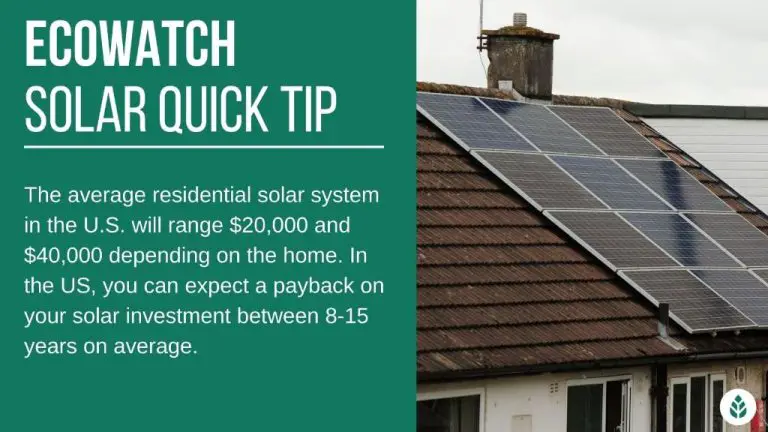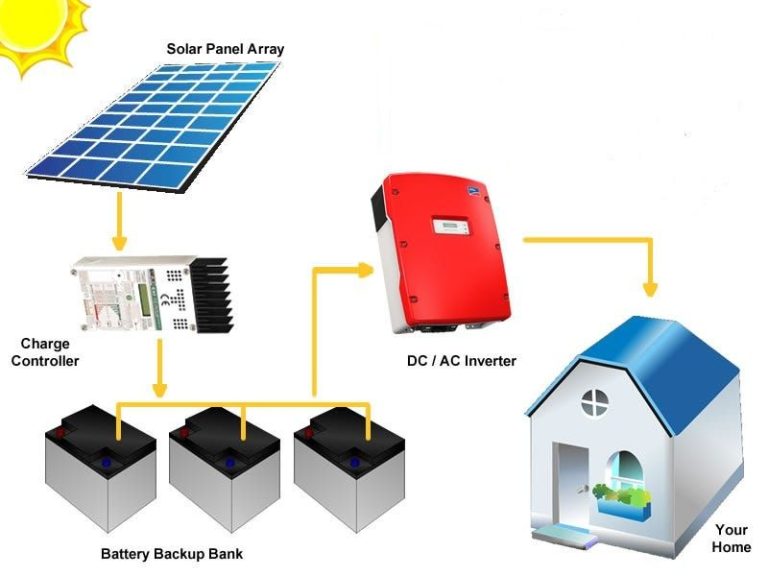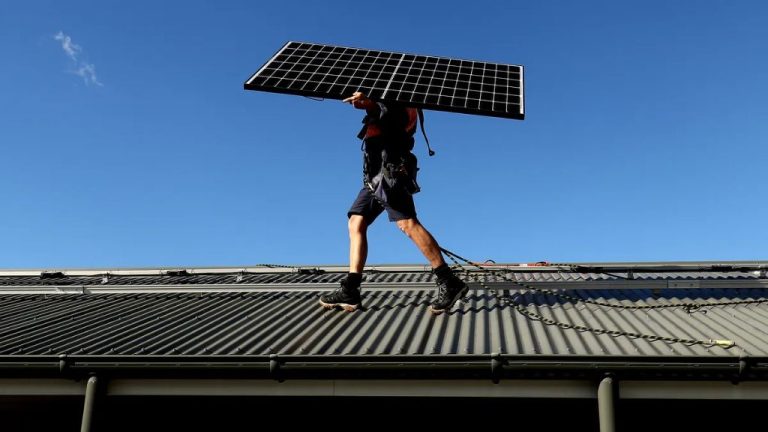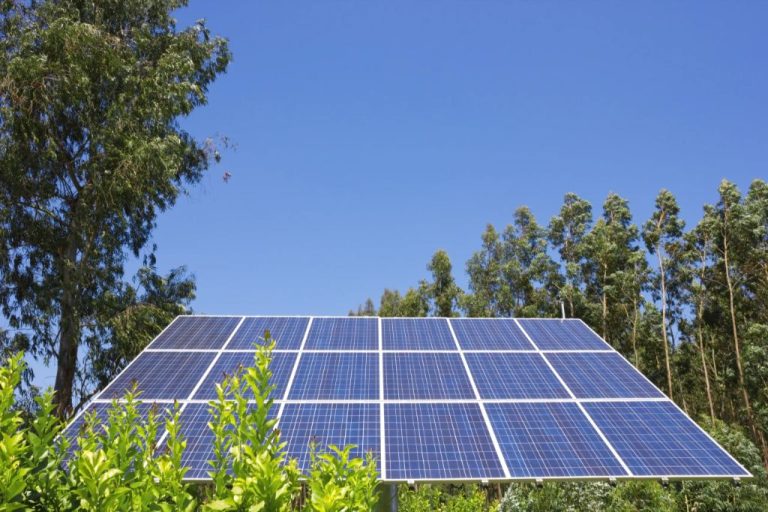Can We Get Solar Energy From Space?
Space-based solar power (SBSP) refers to the concept of collecting solar power in space and distributing it wirelessly to Earth. The idea involves placing enormous solar arrays into orbit and having them beam energy down to ground-based receivers as microwave or laser light.
According to the European Space Agency (ESA), SBSP is based on existing technological principles and known physics, with no new breakthroughs required. The basic idea is to place solar power satellites (SPS) in a geosynchronous orbit above Earth’s atmosphere to avoid weather impacts and take advantage of near-constant solar irradiation. The SPS would collect sunlight up to ten times more efficiently than ground-based solar panels.
The energy would then be converted into microwaves or laser light and beamed wirelessly to receivers on Earth. This energy could then be converted into traditional electricity for use in homes, businesses, and the electric grid.
How Space-Based Solar Power Works
Space-based solar power (SBSP) involves collecting solar energy in space using large solar panels mounted on satellites and converting it into electricity. The key components that enable SBSP are space-based solar collectors, wireless power transmission, and ground reception stations.
The solar collectors would be giant satellites with large solar arrays to capture the sun’s energy. Since there are no clouds and no night in space, the arrays could collect sunlight 24 hours a day. Once the energy is converted to electricity, it would be converted to radio frequency waves and beamed safely to Earth through dedicated receivers.
For wireless power transmission, SBSP systems would use either microwave or laser technology. Microwave transmission involves converting the electricity into microwaves and beaming them through a transmitting antenna to Earth. A receiving antenna on the ground would collect the microwaves and convert them back into electricity for use on Earth’s power grid.
Laser transmission focuses the energy into laser beams at precise wavelengths that can travel long distances without losing much intensity. The beams would be aimed at receiving stations on the ground, which would have photovoltaic arrays tuned to efficiently convert the laser light back into electricity.
The receivers would likely be located in remote areas to minimize impacts on wildlife and aviation. The received power would be fed into the existing electric grid for distribution across existing infrastructure. SBSP aims to provide clean, renewable energy safely and reliably to any location on Earth.
Advantages of Space-Based Solar Power
One of the main advantages of space-based solar power is that it provides an effectively unlimited and constant supply of clean energy. Unlike ground-based solar power which only generates electricity when the sun is shining, space-based systems can collect sunlight 24 hours a day. As noted by the European Space Agency, “A single SBSP satellite in geosynchronous orbit may receive 5–10 times the energy that strikes a ground-based system of the same size” (ESA – Space-Based Solar Power overview). Additionally, the sunlight in space is far more intense without interference from the atmosphere or weather events. This means SBSP can generate significantly more clean energy than terrestrial solar panels.
According to the U.S. Department of Energy, the amount of solar energy striking the Earth every hour is more than the total global human energy consumption for an entire year (https://www.energy.gov/space-based-solar-power). Space-based systems could theoretically collect a massive abundance of solar energy and beam it down to Earth continuously. This exceptional generation capacity makes SBSP a very promising solution for meeting the world’s growing energy needs in a sustainable way without producing greenhouse gases or pollution.
Overall, the main advantages of SBSP are the potential for abundant, uninterrupted clean energy generation from the enormous amounts of solar energy available in space. This could greatly increase the world’s access to renewable energy and reduce dependence on fossil fuels if the technological and economic challenges can be overcome.
Challenges of Space-Based Solar Power
While space-based solar power could provide clean, renewable energy, there are significant challenges to overcome before it becomes economically and technologically viable. Three major challenges include:
High costs – Constructing solar power satellites and launching them into space requires massive capital investments. According to a Caltech study, it could cost over $200 billion to deploy the infrastructure needed. Reducing these costs through improved space launch and transportation systems is necessary.
Technological limitations – The technology for space-based solar power is still in the early research and development phase. Key components like ultralight solar arrays, wireless power transmission systems, and very large-scale satellite and receiver designs need to be further developed and tested before full-scale implementation can occur.
Transmission losses – While wireless power transmission has improved, significant losses can still occur over the large distances involved from space to Earth. Improving transmission efficiency is important for delivering usable amounts of power from orbiting solar arrays.
Overcoming these critical challenges around costs, technology readiness, and transmission will be vital for space-based solar power to evolve from an aspirational concept to an actionable renewable energy source.
Ongoing Research and Development
There are several key research projects underway to further develop the technology for space-based solar power. These include:
The Caltech Space Solar Power Project, led by researchers at CalTech, aims to demonstrate wireless power transmission from space to Earth. In June 2022, they successfully beamed power wirelessly between two spacecraft in orbit using microwave frequencies (CalTech, 2023).
NASA is studying the viability of space-based solar power as part of its Space Technology Mission Directorate. They are researching methods for assembly and maintenance of infrastructure in space as well as wireless power transmission technologies (Department of Energy, 2023).
The European Space Agency (ESA) has an active program called Solaris focused on developing the necessary elements for space-based solar power systems. This includes studies on space transportation, robotics for in-space construction, and wireless transmission methods (ESA, 2023).
Several private companies such as Solaren, HyperSun, and others are also working on early-stage designs and prototypes for space-based solar power systems.
Potential Applications
Space-based solar power has several promising potential applications:
Providing baseload power: Since space-based solar power could provide a constant supply of energy, it could be used to meet baseload electricity demand without intermittency issues. This makes it an attractive option for replacing fossil fuel power plants and supplementing other renewable energy sources like wind and ground-based solar that have variable output.
Off-grid power: SBSP could provide electricity to remote locations on Earth that lack access to an energy grid, like islands and rural communities. By transmitting power wirelessly, SBSP could reach areas difficult to access with wires and poles.
Space missions: SBSP satellites could beam solar energy to spacecraft in orbits beyond low Earth orbit, enabling missions deeper into space. This would provide abundant power for electric thrusters, scientific instruments, and life support systems on crewed spacecraft.
According to an analysis by Caltech and NASA JPL [1], a system of SBSP satellites could have applications in global baseload power, platform charging, and beamed propulsion for space travel.
Economic Viability
The upfront costs associated with developing and deploying space-based solar power systems are substantial. Significant investments in research, development, and infrastructure would be required before commercialization could become feasible. However, proponents argue the long-term returns could make the initial costs worthwhile.
Constructing solar power satellites and transmitters, launching them into orbit, and building receiver stations on Earth will likely cost hundreds of billions of dollars. These facilities would need to operate for decades before breaking even. There are also ongoing operation and maintenance costs to consider.
Compared to conventional ground-based solar farms, space-based systems face extra expenses related to rocket launches and operating in the harsh space environment. However, the consistency and scale of space-based solar power could offset these costs over time. Uninterrupted sunlight in space provides more reliable generation capacity.
When weighing costs versus benefits, space-based solar power compares favorably to other clean energy sources like nuclear fusion that require huge upfront investments before producing returns. And unlike fossil fuels, the “fuel” for space-based solar is free. With sufficient scale and optimized technologies, space-based solar may become cost-competitive.
Political and Regulatory Considerations
Space-based solar power will require unprecedented levels of international cooperation and coordination. The 1967 Outer Space Treaty provides the foundation for international space law and prohibits claims of national sovereignty in space. However, issues around licensing, regulations, and property rights for SBSP infrastructure will need to be addressed.
The International Telecommunication Union (ITU) plays a major role in allocating global radio spectrum and satellite orbits, which would impact SBSP transmission frequencies and orbital positions. The 1979 Moon Treaty sought to establish an international regime governing the exploitation of lunar resources, but was not widely ratified. Nonetheless, legal frameworks for utilizing in-situ space resources will be important for future SBSP development [1].
Within national governments, space agencies would need to work closely with energy regulators to integrate SBSP into electric grids. Clear regulatory frameworks informed by emerging SBSP technologies will be needed to enable private sector investment and commercialization. International cooperation in research and development, such as through the International Space Station, can help pave the way for future policy coordination [2].
Environmental Impact
Space-based solar power would have less direct environmental impact than terrestrial solar power plants, as the solar arrays would be located in space instead of taking up land area on Earth. However, manufacturing and launching the materials and components into orbit would have some environmental footprint.
The space-based arrays would not disrupt natural landscapes, habitats or soils like ground-based solar farms sometimes do. They would also not consume water for cleaning like terrestrial solar panels in dusty regions. This makes space-based solar a very land and water efficient energy source.
However, mining materials, manufacturing components, and launching rockets to construct the space-based systems would inevitably produce pollution and greenhouse gases. The emissions from manufacturing and launch would need to be far less than the emissions avoided by clean energy generation to make the systems worthwhile.
Research shows that space-based solar could potentially offer a net environmental benefit, especially as launch vehicles become more efficient and reusable in the future. But responsible practices would be needed to minimize pollution from production and launch. Overall, space-based solar presents a complex environmental tradeoff of advantages and concerns. [1] [2]
Future Outlook
Space-based solar power is still a nascent technology that faces significant feasibility challenges. However, recent studies have outlined potential pathways for successful development and deployment. According to a 2024 NASA analysis, space-based solar power could become economically viable by 2050 if launch costs are reduced one hundred-fold. This would require major advances in reusable launch vehicle technology [1].
Other experts project earlier timelines, with space-based solar potentially reaching cost parity with conventional renewables as early as 2040 [2]. This will require overcoming engineering hurdles in areas like wireless power transmission and robotic in-space assembly. It will also require substantial private and/or public investment in R&D and infrastructure.
If these challenges can be addressed, space-based solar may complement conventional solar, wind, and other renewables. It offers major advantages like 24/7 baseload power unaffected by weather. Solar panels in geosynchronous orbit also receive over 99% of available sunlight versus 15-20% on Earth. This makes it a potential clean energy solution for replacing fossil fuel baseload generation [3].





